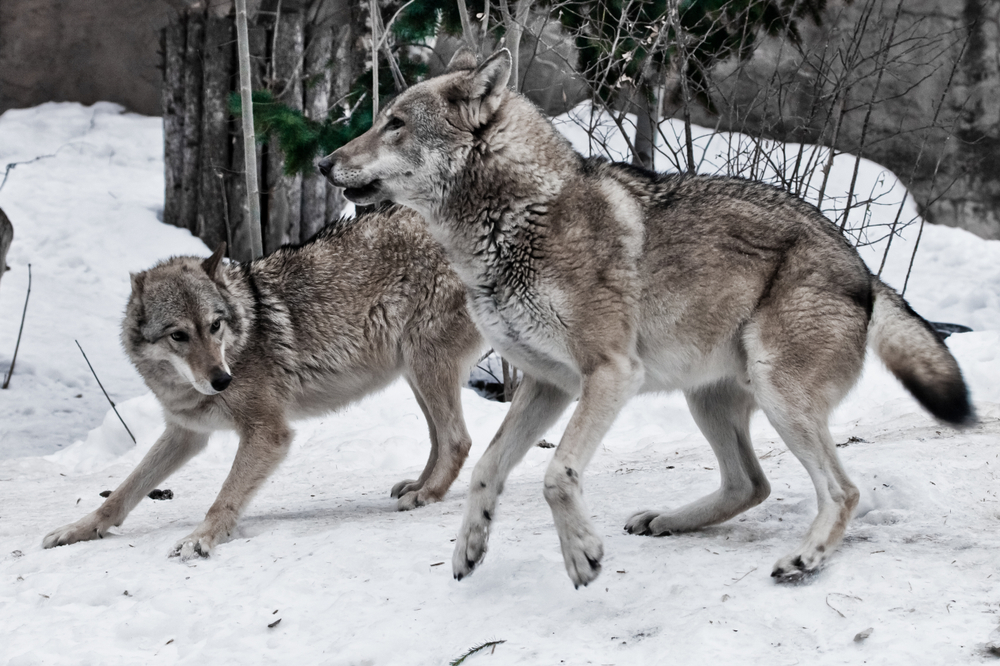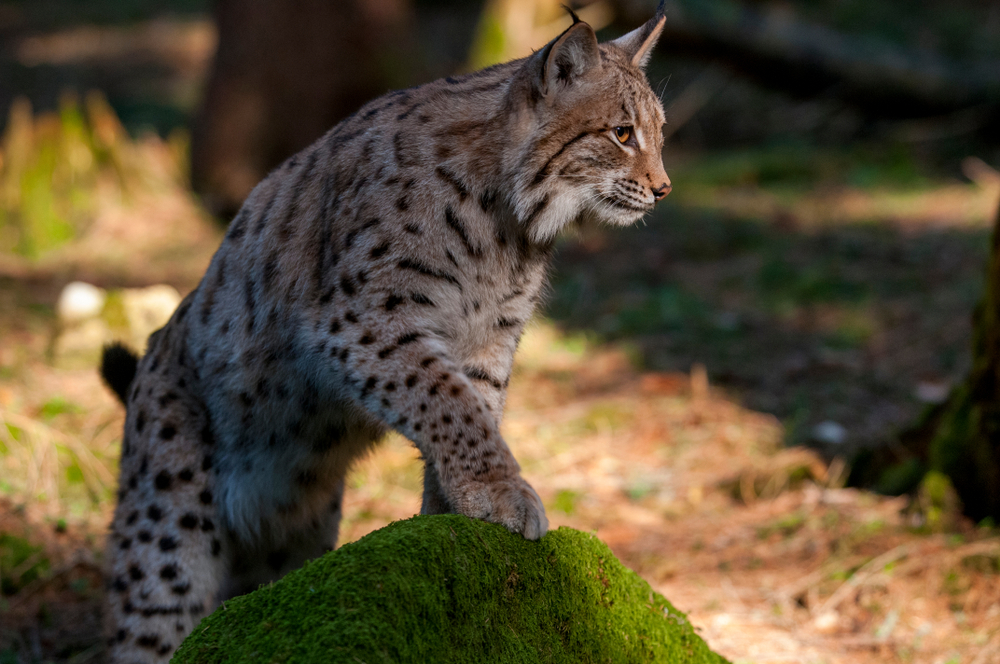LECA, coexisting with large carnivores in the Carpathians and Europe
Large carnivores are returning to populate more and more natural areas of the Old Continent: a success for the conservation of ecosystems, but also a cause of conflicts with the population. Coexistence is built by harmonising laws, good practices, and scientific knowledge. The Interreg LECA project moves in this direction

LECA-coesistere-con-i-grandi-carnivori-nei-Carpazi-e-in-Europa
Brown bear mother and cub in the Romanian forest © Ondrej Prosicky/Shutterstock
If the relationship with large carnivores is a theme as old as man, each country has declined it in a different way. Since the transition from more or less harsh policies of persecution to strict protection, under the umbrella of international conventions such as the Bern Convention for the Conservation of Wild Life and in Europe the Habitat Directive, the situation has changed. Yet, despite the declared unity of purpose, shared management remains a mirage.
The Carpathian forests are home to the largest population of brown bears on the continent (around 8,000 individuals), one among the largest of wolves (over 4,000 individuals), and about 2,500 Carpathian lynxes, a subspecies of the Eurasian lynx. An oasis of fundamental biodiversity, yet endangered by high rates of deforestation, still widespread poaching, and a still relatively low percentage of protected areas. If in the eastern sector, especially in Romania, the presence of carnivores is almost taken for granted, the same cannot be said for the countries to the west of the chain. In Poland, Slovakia, and the Czech Republic, discrepancies in management risk not only exacerbating problems and conflicts with humans, but also compromising the long-term return of species that had almost disappeared until a few years ago.
For these reasons, last April LECA (Supporting the coexistence and conservation of Carpathian LargE CArnivores ) was launched, a three-year project within the Interreg Central Europe programme, coordinated by the Mendel University of Brno, with a budget of 2.93 million Euros, 80% financed by the European Regional Development Fund. Until March 2026, the member countries (Czech Republic, Slovakia, Poland, Hungary, Ukraine, and Romania) plus Slovenia, the only partner outside the Carpathians, will work to harmonise the monitoring and management of wolves, lynxes, and bears and prevent conflicts with human activities.
Monitoring
“Large carnivores know no borders, and their populations move between countries. Therefore long-term coexistence is not possible without international cooperation”, comments Martin Dul’a, researcher at the University of Brno and project coordinator.
The first step, explains the researcher, is to harmonise the monitoring and collection of scientific data. "We need to make decisions based on scientific evidence. Harmonised procedures are needed to count and observe the behaviour of carnivores on all sides of the borders. Only with this data will we be able to act on conflict prevention".
Experts have chosen to focus on four cross-border pilot areas, primarily dedicated to different species. In the Kysucké Beskydy mountains, between Slovakia and the Czech Republic, the wolf will be studied, in close collaboration with experts from the Slovenian forest service.
An area of the Tatra mountains shared between Poland and Slovakia will instead be dedicated to the brown bear, this time with the contribution of Romania, a country that hosts the largest population of bears in Europe.
The other two – the area of the Bieszczady mountains between Slovakia, Poland, and Ukraine, and one which includes the "Slovak Karst", between Slovakia and Hungary – will be dedicated to the lynx.
For wolf monitoring, Czech and Slovak experts are working together with the Forest Service of Slovenia, a country that boasts a long experience in the management of large carnivores and where the damage caused by the wolf, despite an increasing population, has been decreasing for some years.
"We will use radio collars to obtain data on the expansion of the populations that colonise the Alpine area from the Dinaric area, to then compare them with those of Kysucké Beskydy", explains researcher Vesna Mihelič Oražem from Ljubljana. "In a later stage we will work on concrete prevention measures and education, so as to link the educational programme with work on farms".
Conflict and emergency management
If the widespread opinion is that conflict is on the increase everywhere, we read on the official page of the project, in fact we do not even know if this is due to the increase in carnivore populations or simply to the fact that the data so far have not been collected consistently.
When one thinks of the risks to human safety, in Europe the brown bear that stands out, with over 300 attacks in the last twenty years.
"The bear creates tensions with farmers and beekeepers, but the possibility of attacks on people puts the conflict on another level compared to other carnivores", comments Dul’a. "Sometimes those who live in the immediate vicinity of forests and tourists are frightened and they prefer to avoid going into the woods. They think bears are everywhere".
Here too, for the scholar, the important thing is to maintain an approach based on facts and act on communication. "Bears generally avoid people. The chances of meeting them increase at certain times of the year such as the mating season, between spring and early summer, when males are particularly active. Females, on the other hand, sometimes , choose areas close to villages, to prevent males from running into puppies. But we have to explain these things". With correct behaviour, he explains, the risk of aggression drops enormously.
The area of greatest conflict is that of the Tatra Mountains, especially on the Slovakian side, where in 2021, for the first time since the country’s independence in 1993, a deadly attack took place. "If we analyse the data, the number of attacks does not appear to have increased significantly. There are some fluctuations mainly related to the bear mating season, and also to the presence or absence of specific groups of people such as hunters and forest workers".
Even if the project is focused on the western areas of the Carpathians, for the coexistence with the bear the team collaborates with Romania. Between successful conservation efforts and, on the other hand, the greatest number of attacks on the continent, in no other country is coexistence with the bear so entrenched.
"We have been chosen as reference areas on the basis of our numerous experiences, both positive and negative, with large carnivores. Experiences that have resulted in various projects related to improving people’s tolerance, in the prevention and control of poaching", explains Radu Mot, of the Romanian NGO Zarand. "On a small scale, we mirror many of the situations that are happening today, or could happen in the future, not only in the Western Carpathians but in the rest of Europe".
Emergency management also varies from country to country. "In Slovakia we have a special emergency team that deals with problematic bears, and also in Poland in the Tatra mountains there is also an official bear intervention group", explains Dul’a, but at the transnational level, however, there is no shared procedure. Even if, unlike what happened recently in Trentino, the scholar comments, the polarisation of public opinion is attenuated by the fact that in all partner countries the "problematic" specimens are removed (that is, almost always, culled) without much media hype.
As far as the wolf is concerned, the danger of attacks on humans is practically nil, but the same cannot be said for livestock, especially in more recently colonised areas, where the habit of adequately protecting livestock has been lost.
"Grazing animals are too easy food for wolves. The adoption of preventive measures such as electric fences and guard dogs is completely insufficient for now. And then there is the conflict with the hunters, as they vie for the same prey. The conflict is especially felt in the Czech Republic and Slovakia, where the hunting management of game is very intensive, with an enormous number of game reserves, especially for ungulates".
In theory, bears and lynxes are also competitors, but the evidence is demonstrating in an increasingly unequivocal way that the contribution of bears is marginal and that of the lynx is negligible. "Although they are large carnivores, we are realising that the conflict with the lynx is very low".
Keeping the conflict with human activities under control is not only essential to protect the activities of humans living in the mountains, in often disadvantaged areas, but also to prevent poaching, still rampant in many sectors of the chain. The phenomenon, explains the scholar, is today in the Carpathians the most limiting factor for the populations of large carnivores.
European look
Another major issue that the partners will have to face are the removals, "in exception" to the laws that protect them, of a certain number of specimens. The aim, in theory, is to keep populations and therefore the opportunities for conflict under control. In practice, partner countries adopt completely different criteria with outcomes that spread well beyond borders.
In Slovakia, for example, more than 70 bears were legally culled between 2000 and 2009, and around eight wolves were killed each year up to 2021, regardless of the assessment of the health of the population, and this negatively affected the return of the species to the Czech Republic.
"The problem goes far beyond the Carpathians and also affects the Alpine countries", comments Rok Černe of the Slovenian Forest Service. "And that creates acceptance problems. It’s hard to convince farmers that one species can’t be touched while just across the border it’s the other way around. All countries should take the same responsibility for maintaining stable populations of carnivores, although of course it’s necessary to keep account of the specificity of the situations".
Going beyond the borders of the Carpathians has been part of the project since its initial stages. After field-testing the different prevention approaches and measures, the project partners will prepare harmonised guidelines that they will share with other actors.
“We would like to share experiences and results, including any adverse findings, and replicate good solutions nationally and transnationally”, explains Dul’a. "Not only with the countries that adhere to the Carpathian Convention, but also with those of the Alps, as well as with groups of scientists or institutions of nations, such as Italy, which have found themselves facing the great issue of coexistence in recent years".
This content is published in the context of the “Work4Future” project co-financed by the European Union (EU). The EU is in no way responsible for the information or views expressed within the framework of the project. The responsibility for the contents lies solely with OBC Transeuropa. Go to the “Work4Future“
Tag: Work for Future
Featured articles
- Take part in the survey
LECA, coexisting with large carnivores in the Carpathians and Europe
Large carnivores are returning to populate more and more natural areas of the Old Continent: a success for the conservation of ecosystems, but also a cause of conflicts with the population. Coexistence is built by harmonising laws, good practices, and scientific knowledge. The Interreg LECA project moves in this direction

LECA-coesistere-con-i-grandi-carnivori-nei-Carpazi-e-in-Europa
Brown bear mother and cub in the Romanian forest © Ondrej Prosicky/Shutterstock
If the relationship with large carnivores is a theme as old as man, each country has declined it in a different way. Since the transition from more or less harsh policies of persecution to strict protection, under the umbrella of international conventions such as the Bern Convention for the Conservation of Wild Life and in Europe the Habitat Directive, the situation has changed. Yet, despite the declared unity of purpose, shared management remains a mirage.
The Carpathian forests are home to the largest population of brown bears on the continent (around 8,000 individuals), one among the largest of wolves (over 4,000 individuals), and about 2,500 Carpathian lynxes, a subspecies of the Eurasian lynx. An oasis of fundamental biodiversity, yet endangered by high rates of deforestation, still widespread poaching, and a still relatively low percentage of protected areas. If in the eastern sector, especially in Romania, the presence of carnivores is almost taken for granted, the same cannot be said for the countries to the west of the chain. In Poland, Slovakia, and the Czech Republic, discrepancies in management risk not only exacerbating problems and conflicts with humans, but also compromising the long-term return of species that had almost disappeared until a few years ago.
For these reasons, last April LECA (Supporting the coexistence and conservation of Carpathian LargE CArnivores ) was launched, a three-year project within the Interreg Central Europe programme, coordinated by the Mendel University of Brno, with a budget of 2.93 million Euros, 80% financed by the European Regional Development Fund. Until March 2026, the member countries (Czech Republic, Slovakia, Poland, Hungary, Ukraine, and Romania) plus Slovenia, the only partner outside the Carpathians, will work to harmonise the monitoring and management of wolves, lynxes, and bears and prevent conflicts with human activities.
Monitoring
“Large carnivores know no borders, and their populations move between countries. Therefore long-term coexistence is not possible without international cooperation”, comments Martin Dul’a, researcher at the University of Brno and project coordinator.
The first step, explains the researcher, is to harmonise the monitoring and collection of scientific data. "We need to make decisions based on scientific evidence. Harmonised procedures are needed to count and observe the behaviour of carnivores on all sides of the borders. Only with this data will we be able to act on conflict prevention".
Experts have chosen to focus on four cross-border pilot areas, primarily dedicated to different species. In the Kysucké Beskydy mountains, between Slovakia and the Czech Republic, the wolf will be studied, in close collaboration with experts from the Slovenian forest service.
An area of the Tatra mountains shared between Poland and Slovakia will instead be dedicated to the brown bear, this time with the contribution of Romania, a country that hosts the largest population of bears in Europe.
The other two – the area of the Bieszczady mountains between Slovakia, Poland, and Ukraine, and one which includes the "Slovak Karst", between Slovakia and Hungary – will be dedicated to the lynx.
For wolf monitoring, Czech and Slovak experts are working together with the Forest Service of Slovenia, a country that boasts a long experience in the management of large carnivores and where the damage caused by the wolf, despite an increasing population, has been decreasing for some years.
"We will use radio collars to obtain data on the expansion of the populations that colonise the Alpine area from the Dinaric area, to then compare them with those of Kysucké Beskydy", explains researcher Vesna Mihelič Oražem from Ljubljana. "In a later stage we will work on concrete prevention measures and education, so as to link the educational programme with work on farms".
Conflict and emergency management
If the widespread opinion is that conflict is on the increase everywhere, we read on the official page of the project, in fact we do not even know if this is due to the increase in carnivore populations or simply to the fact that the data so far have not been collected consistently.
When one thinks of the risks to human safety, in Europe the brown bear that stands out, with over 300 attacks in the last twenty years.
"The bear creates tensions with farmers and beekeepers, but the possibility of attacks on people puts the conflict on another level compared to other carnivores", comments Dul’a. "Sometimes those who live in the immediate vicinity of forests and tourists are frightened and they prefer to avoid going into the woods. They think bears are everywhere".
Here too, for the scholar, the important thing is to maintain an approach based on facts and act on communication. "Bears generally avoid people. The chances of meeting them increase at certain times of the year such as the mating season, between spring and early summer, when males are particularly active. Females, on the other hand, sometimes , choose areas close to villages, to prevent males from running into puppies. But we have to explain these things". With correct behaviour, he explains, the risk of aggression drops enormously.
The area of greatest conflict is that of the Tatra Mountains, especially on the Slovakian side, where in 2021, for the first time since the country’s independence in 1993, a deadly attack took place. "If we analyse the data, the number of attacks does not appear to have increased significantly. There are some fluctuations mainly related to the bear mating season, and also to the presence or absence of specific groups of people such as hunters and forest workers".
Even if the project is focused on the western areas of the Carpathians, for the coexistence with the bear the team collaborates with Romania. Between successful conservation efforts and, on the other hand, the greatest number of attacks on the continent, in no other country is coexistence with the bear so entrenched.
"We have been chosen as reference areas on the basis of our numerous experiences, both positive and negative, with large carnivores. Experiences that have resulted in various projects related to improving people’s tolerance, in the prevention and control of poaching", explains Radu Mot, of the Romanian NGO Zarand. "On a small scale, we mirror many of the situations that are happening today, or could happen in the future, not only in the Western Carpathians but in the rest of Europe".
Emergency management also varies from country to country. "In Slovakia we have a special emergency team that deals with problematic bears, and also in Poland in the Tatra mountains there is also an official bear intervention group", explains Dul’a, but at the transnational level, however, there is no shared procedure. Even if, unlike what happened recently in Trentino, the scholar comments, the polarisation of public opinion is attenuated by the fact that in all partner countries the "problematic" specimens are removed (that is, almost always, culled) without much media hype.
As far as the wolf is concerned, the danger of attacks on humans is practically nil, but the same cannot be said for livestock, especially in more recently colonised areas, where the habit of adequately protecting livestock has been lost.
"Grazing animals are too easy food for wolves. The adoption of preventive measures such as electric fences and guard dogs is completely insufficient for now. And then there is the conflict with the hunters, as they vie for the same prey. The conflict is especially felt in the Czech Republic and Slovakia, where the hunting management of game is very intensive, with an enormous number of game reserves, especially for ungulates".
In theory, bears and lynxes are also competitors, but the evidence is demonstrating in an increasingly unequivocal way that the contribution of bears is marginal and that of the lynx is negligible. "Although they are large carnivores, we are realising that the conflict with the lynx is very low".
Keeping the conflict with human activities under control is not only essential to protect the activities of humans living in the mountains, in often disadvantaged areas, but also to prevent poaching, still rampant in many sectors of the chain. The phenomenon, explains the scholar, is today in the Carpathians the most limiting factor for the populations of large carnivores.
European look
Another major issue that the partners will have to face are the removals, "in exception" to the laws that protect them, of a certain number of specimens. The aim, in theory, is to keep populations and therefore the opportunities for conflict under control. In practice, partner countries adopt completely different criteria with outcomes that spread well beyond borders.
In Slovakia, for example, more than 70 bears were legally culled between 2000 and 2009, and around eight wolves were killed each year up to 2021, regardless of the assessment of the health of the population, and this negatively affected the return of the species to the Czech Republic.
"The problem goes far beyond the Carpathians and also affects the Alpine countries", comments Rok Černe of the Slovenian Forest Service. "And that creates acceptance problems. It’s hard to convince farmers that one species can’t be touched while just across the border it’s the other way around. All countries should take the same responsibility for maintaining stable populations of carnivores, although of course it’s necessary to keep account of the specificity of the situations".
Going beyond the borders of the Carpathians has been part of the project since its initial stages. After field-testing the different prevention approaches and measures, the project partners will prepare harmonised guidelines that they will share with other actors.
“We would like to share experiences and results, including any adverse findings, and replicate good solutions nationally and transnationally”, explains Dul’a. "Not only with the countries that adhere to the Carpathian Convention, but also with those of the Alps, as well as with groups of scientists or institutions of nations, such as Italy, which have found themselves facing the great issue of coexistence in recent years".
This content is published in the context of the “Work4Future” project co-financed by the European Union (EU). The EU is in no way responsible for the information or views expressed within the framework of the project. The responsibility for the contents lies solely with OBC Transeuropa. Go to the “Work4Future“
Tag: Work for Future












